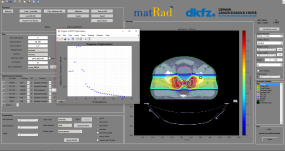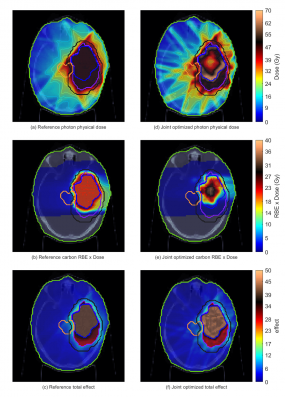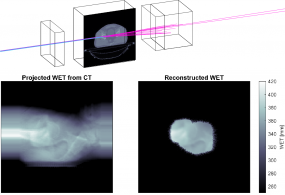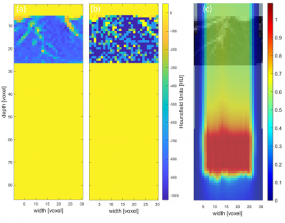Radiotherapy Optimization - Projects
- matRad - open source dose calculation and treatment planning for research and education
- Joint optimization of mixed-modality treatments
- Inverse Radiotherapy Treatment Planning using Machine Learning Outcome Prediction Models
- HELIOS – Developing a HELium Imaging Oncology Scanner for Range Guided Radiotherapy
- Data-Driven CBCT Image Quality Improvements and Patient-Specific Quantitative Evaluation
- Dose Calculation for intensity-modulated particle therapy in Lung
matRad - open source dose calculation and treatment planning for research and education

© dkfz.de
matRad is an open source software for radiation treatment planning of intensity-modulated photon, proton, and carbon ion therapy. matRad is developed for educational and research purposes. It is entirely written in MATLAB.
matRad Features

© dkfz.de
matRad comprises
- MATLAB functions to model the entire treatment planning workflow
- Example patient data
- Physical and biological base data for all required computations
In particular we provide functionalities for
- Ray tracing
- Photon dose calculation
- Proton dose calculation
- Carbon ion dose calculation (including 3D RBE modeling)
- Inverse planning (based on physical dose and biological effect)
- Multileaf collimator sequencing
- Basic treatment plan visualization and evaluation
matRad is constantly evolving. If you are looking for a special feature do not hesitate and get in touch.
matRad developments were/are, in part, supported by the following research grants:
- Grant No. BA 2279/3-1 (Project No. 265744405) from the German Research Foundation (DFG)
- Grant No. WA 4707/1-1 (Project No. 443188743) from the German Research Foundation (DFG)
- Grant No. 70113094 from the German Cancer Aid
People
- Dr. Niklas Wahl - Maintainer, Lead Developer
- Dr. Amit Ben Antony Bennan - Co-lead developer
- All the other people of the group Radiotherapy Optimization
Links
Joint optimization of mixed-modality treatments

© dkfz.de
The joint optimization of mixed modality treatments is a research field was initiated to address the under-utilized potential of combined radiotherapy treatments and to make smarter use of limited particle therapy treatment resources. Traditionally combined photon - particle radiotherapy treatments are generated by separately optimizing treatment plans for each modality and summing up the predicted effective dose. This does not take into account the interplay of the distinct physical and radiobiological characteristics of the selected modalities.
In order to better utilize each modality, we have developed an approach within matRad to simultaneously optimize all modalities over the entire treatment course based on the total biological effect. Such an approach takes advantage of the unique dose deposition characteristics, relative biological effectiveness (RBE) and fractionation ability.
Jointly optimized combined treatments show potential in generating more conformal treatment plans that utilize the fractionation effect to protect critical structures. This in turn offers clinicians novel treatment options utilizing existing radiotherapy resources.
People
- Amit Bennan (Postdoc)
- Remo Cristoforetti (PhD student)
- Tobias Becher (Master Student)
- Jan Unkelbach (Collaboration Partner / Advisor)
- Niklas Wahl (Advisor / PI)
- Mark Bangert (former PI)
Inverse Radiotherapy Treatment Planning using Machine Learning Outcome Prediction Models
© dkfz.de
Half of all cancer patients receive radiation therapy which delivers high-energetic, ionizing radiation to target cancerous tissue while sparing healthy tissue. The planning of such a radiotherapeutic intervention is highly personalized due to the application of medical imaging techniques like computed tomography or magnetic resonance imaging followed by simulation and optimization of the radiation dosage. In the classical approach to treatment planning, the underlying trade-off between tumor control probability (TCP) and normal tissue complication probability (NTCP) is usually taken into account only in an indirect manner by using surrogate planning objectives depending on empirical dose prescriptions and tolerances, instead of performing a „biological optimization" based on these two quantities. However, in the current literature there are technically feasible approaches to integrate TCP and NTCP directly into the plan optimization process. Unfortunately, these approaches rely on simple analytical models with low-dimensional parameter spaces, e.g. the logistic LKB model, and are therefore consistently questioned with respect to accuracy and usability. Therefore, the proposed project aims at superseding these approaches by integrating state-of-theart Machine Learning (ML) models for TCP and NTCP into the radiotherapy treatment plan optimization process, which poses multiple mathematical, computational, and clinical challenges. In summary, the following project objectives are set:
- Investigation and definition of ML-based model stability within the dose optimization environment given untypical input during optimization iterations
- Development of computationally efficient optimization objective and constraint functions based on ML models, especially with respect to differentiability and respective efficient gradient computations
- Interpretation of generated treatment plans and definition of clinically acceptable optimization strategies
Additional output is planned to be a (partly open-source) software module for further research and pre-clinical testing.
People
- Tim Ortkamp (PhD student)
- Prof. Martin Frank (PI)
- Prof. Oliver Jäkel (PI)
- Dr. Niklas Wahl (CI)
Links
HELIOS – Developing a HELium Imaging Oncology Scanner for Range Guided Radiotherapy

© dkfz.de
Intensity modulated particle therapy (IMPT) with carbon ions is a promising treatment modality for tumors. Recently, a mixed carbon/helium beam has been proposed for online monitoring in carbon ion therapy. Fully ionized helium and carbon ions have the same mass/charge ratio, this allows for simultaneous acceleration in a synchrotron to the same energy per nucleon. Here, helium ions have about three times the range of carbon ions. This could allow for simultaneous use of the carbon ions for treatment and the helium ions for imaging.
We are working on developing a range guided dose calculation framework that can simulate the dose of mixed 12C/4He beams and the corresponding range radiographs for typical irradiation geometries and uncertainty estimates. This can be used to estimate the actually dose that was delivered during treatment, than can vary severely from the planned dose through patient motion and set up errors.
The project is funded by DFG, Grant No. WA 4707/3-1, Project No. 457509854.
Data-Driven CBCT Image Quality Improvements and Patient-Specific Quantitative Evaluation
The project aims at bridging the gap between the Cone-beam CT (CBCT) image quality, which is currently limited in its capabilities to patient positioning, and the image quality of planning CTs. The idea is to employ classical and machine learning methods to increase contrast and reduce scatter and metal artifacts enabling reliable adaptive treatment planning based on CBCT images alone.
The first approach will focus on the impact of typical image quality shortcomings of CBCT on plan quality degradation in photon beam treatments. This will enable optimizing corrections with respect to their clinical value. The second - machine learning - aspect will approach the problem from the angle of generating synthetic CTs from CBCTs by using a form of generative adversarial networks (GAN). The network will potentially not only learn based on the difference in image quality as such, but on the treatment plans that are created using these images as well.
Additionally, a project looking at Bayesian neural networks (BNN) is underway. This approach to neural networks will aid us in understanding the uncertainties with which the predictions are being generated and will thus increase the explainability aspect of the newly developed generative algorithms.
The project is funded by Varian Medical Systems, a Siemens Healthineers company and is done in collaboration with Fabian Jäger and Marc Kachelrieß from the division E025 – Division of X-Ray Imaging and Computed Tomography.
The project is funded by Varian.
People
- Goran Stanic (PhD student)
- Fabian Jäger (PhD student)
- Prof. Oliver Jäkel (PI)
- Prof. Marc Kachelrieß (PI)
- Dr. Kristina Giske (Advisor)
- Dr. Niklas Wahl (Advisor)
Links
Dose Calculation for intensity-modulated particle therapy in Lung

Waterphantom with slab of lung copied from a real patient (a), phantom with binomially sampled lung (b), and calculated dose slice averaged over 100 samples (c).
© dkfz.de
Tumor treatment using particles has gained more traction in the past years with more centers being opened each year. Due to the so-called Bragg peak, particles exhibit a dose distribution which is more confined to the tumor region compared to photons. This generally reduces the toxicity in non-tumor tissues and organs at risk . However, tumors that are in or close to lung pose a variety of problems in the treatment planning workflow and particles are more prone to spatial errors such as internal motion due to breathing and setup-related uncertainties. Very fine substructures in lung tissue cause a degradation of the treatment beam which results in additional straggling of the particles and a widened Bragg peak and can lead to an inaccurate dose delivery to the target volume and more dose applied to organs at risk. Since these structures are below the resolution of typical clinical imaging, they are usually not considered in treatment planning.
It is therefore necessary to implement mathematical degradation models in both deterministic and Monte Carlo (MC) dose calculation and treatment planning. This project implements such corrected algorithms into the open-source treatment planning toolkit matRad. A deterministic algorithm based on convolutions was developed based on kernel convolutions. For Monte Carlo dose calculation, the project first implements a comprehensive and sustainable MC interface into matRad, that allows both dose calculation for inverse planning and forward dose calculation with established MC tools like MCsquare and TOPAS. Then, a voxel tissue and density sampling algorithm was implemented where the individual lung voxels are sampled according to adequate probability distributions representing the microscopic structure, with the final dose calculation aggregated over a sufficent number of such sampled simulations.
The project is funded by the German Cancer Aid, Grant No. 70113094.
People
- Noa Homolka (PhD Student)
- Dr. Malte Ellerbrock (Medical Physicist)
- Prof. Oliver Jäkel (PI)
- Dr. Niklas Wahl (CI)
